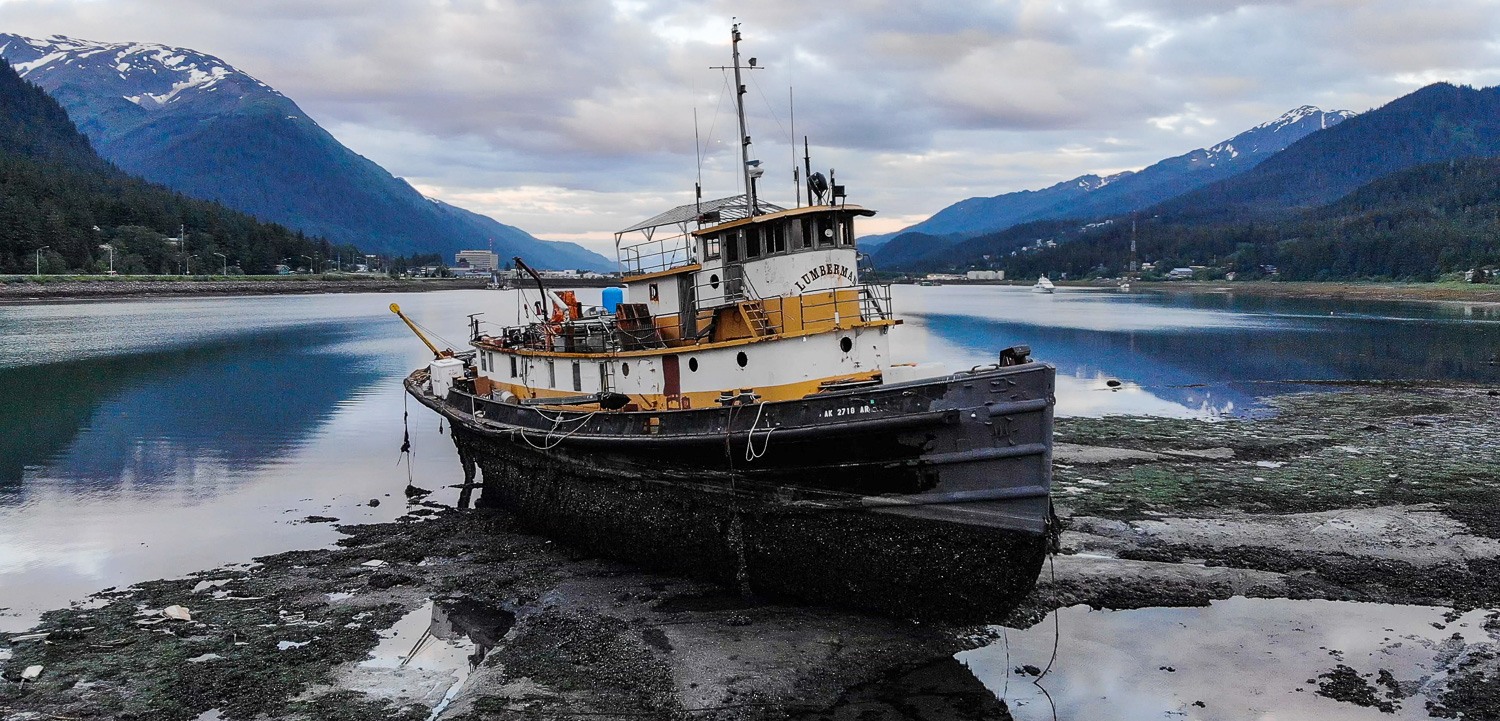Dead in the Water
As abandoned and derelict boats multiply from Alaska to California, officials scramble for solutions.
Article body copy
This article was originally published in High Country News, a magazine about the American West’s environment and communities. Read more stories like this at hcn.org.
The Lumberman, a 33-meter Second World War–era steel-hull tugboat, has been floating at the quiet cruise ship dock in Juneau, Alaska, for months, awaiting a watery grave. Abandoned for nearly a decade, the Lumberman was moored in Juneau’s Gastineau Channel in the early 2000s by its last owner, Brenden Mattson. Two years ago, the tugboat’s anchor line broke, stranding it on state tidelands and creating a jurisdictional hot potato for city, state, and coast guard officials as they debated how to dispose of the vessel.
Then, last winter, a high tide and forceful winds pushed the Lumberman from the tidelands. Fearing property damage, the City of Juneau took responsibility for the historical tug and towed it to the cruise ship dock. In late October, Juneau got permission from the Environmental Protection Agency to get rid of the boat: by scuttling it offshore, about 274 kilometers from the city. This spring, weather permitting, city officials will open a 15-centimeter valve on the ship, allowing it to sink 2,560 meters to the ocean floor.
This is an uncommon way to deal with a common problem in coastal areas: what to do with abandoned and derelict vessels. Hundreds of such boats are strewn along Alaska’s coast, where they can become navigational hazards or dangerously alluring destinations. In 2017, two people who were trying to reach the Lumberman died when their skiff overturned. Abandoned boats can also damage habitat and leach toxic materials, such as lead paint, asbestos, and household cleaners, threatening coastal environments. Each state along the US West Coast would need over US $20-million to handle the backlog, and close to $5-million annually to address the ongoing problem. On Alaska’s remote shorelines, these costs can double.
There are many reasons a boat may be abandoned: the owner can die or become unable to continue the boat’s upkeep, or the cost of either maintenance or disposal can be prohibitive. “People generally don’t walk away from the nicer boats that have value,” says Matthew Creswell, harbormaster at Juneau’s Docks and Harbors. “They walk away from the boats costing an arm and a leg to get rid of.”
The cost of removal varies by a vessel’s size and location. On Alaska’s expansive coasts, where infrastructure is sparse, prices are particularly high. The Lumberman, for example, could be discarded and hauled to a landfill, or transported by barge to Seattle, Washington, but either option would cost between $250,000 and $400,000, Creswell says. Sinking is a bargain in comparison, but it will still cost Juneau Docks and Harbors over $100,000 for towing, removing trash, and stripping toxic lead paint from the vessel. “It’s not a common method,” Creswell says. “But in this case with the Lumberman, [scuttling] was the most cost-effective method.”
Juneau discards about a dozen boats annually. Most are smaller than the Lumberman and easier to remove and salvage locally. But long-abandoned boats are piling up: by 2025, Alaska’s fleet will include more than 3,000 vessels between 8.5 and 18 meters long that are over 45 years old—past the point of a useful life for most boats—according to the Alaska-based McKinley Research Group.
In 2017, cast-off boats caught the attention of the Pacific States/British Columbia Oil Spill Task Force, an intergovernmental group that promotes coordination in addressing oil spills. The task force labeled derelict and abandoned vessels a “critical, emerging issue” and established a work group to explore the problem. “There is a strong sense from everybody who deals with the issue that it is getting worse pretty much everywhere [on the West Coast],” says Hilary Wilkinson, an environmental consultant in Washington who helps lead the task force and chairs its abandoned vessel work group.
The work group recommends that states look to Washington, which is considered to have a model boat-disposal program—one focused on prevention, owner responsibility, and generating funds for removal. Any owner who cannot pay for disposal of a derelict, but floating, vessel that’s less than 14 meters long can ask the Washington State Department of Natural Resources to remove it for free. The program handles about 20 boats annually, using money collected from vessel registration fees.
Adequate funding is a “major obstacle” for every West Coast state, according to the work group’s findings. Aaron Timian, Alaska’s abandoned and derelict vessel coordinator, says the state is still developing ways to secure funds. In response to mounting issues caused by vessels like the Lumberman, the state passed legislation in 2018 establishing the program that Timian now leads. The law, which requires boats longer than 24 feet (7.3 meters) to have a title, simplified the impoundment process and added civil penalties and enforcement authority. The paper trail should also make it easier for authorities to track down owners. While it’s too soon to tell if it will be effective, Creswell said, “It’s totally a step in the right direction.”

